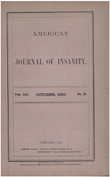Suicide among subjects with personality disorders
Abstract
OBJECTIVE: There have been few psychological autopsy studies of suicide among individuals with personality disorders. The possible specificity of characteristics of suicide among such individuals has been little investigated. METHOD: A random sample of 229 subjects who committed suicide, representing all suicide victims in Finland within a 12-month period, were comprehensively examined by using the psychological autopsy method and were diagnosed according to DSM-III-R criteria. Within this random sample the authors investigated all subjects with axis II personality disorders (N = 67) and divided them into clusters B (N = 43), C (N = 23), and A (N = 1). Individuals with clusters B and C personality disorders were separately compared with sex- and age- matched suicide victims without personality disorder, in terms of sociodemographic characteristics, comorbid axis I and III syndromes, treatment histories, previous suicide attempts, communication of suicide intent, and suicide methods. RESULTS: All suicide victims with a personality disorder received at least one axis I diagnosis. In 95% this included a depressive syndrome, a psychoactive substance use disorder, or both. Individuals with cluster B personality disorders were more likely than comparison subjects to have psychoactive substance use disorders (79% versus 40%) and previous nonfatal suicide attempts (70% versus 37%) and were less likely to have axis III physical disorders (29% versus 50%). Subjects with cluster C personality disorders were not found to differ from the control subjects in any of the variables examined. CONCLUSIONS: Suicide victims with personality disorders were almost always found to have had current depressive syndromes, psychoactive substance use disorders, or both. Suicide victims with cluster B personality disorders differed from other suicide victims in several characteristics, while those with cluster C personality disorders did not.
Access content
To read the fulltext, please use one of the options below to sign in or purchase access.- Personal login
- Institutional Login
- Sign in via OpenAthens
- Register for access
-
Please login/register if you wish to pair your device and check access availability.
Not a subscriber?
PsychiatryOnline subscription options offer access to the DSM-5 library, books, journals, CME, and patient resources. This all-in-one virtual library provides psychiatrists and mental health professionals with key resources for diagnosis, treatment, research, and professional development.
Need more help? PsychiatryOnline Customer Service may be reached by emailing [email protected] or by calling 800-368-5777 (in the U.S.) or 703-907-7322 (outside the U.S.).



